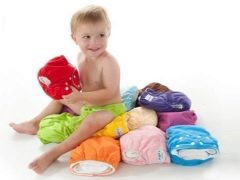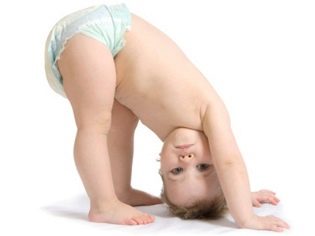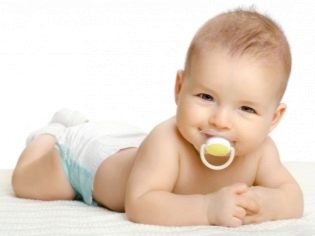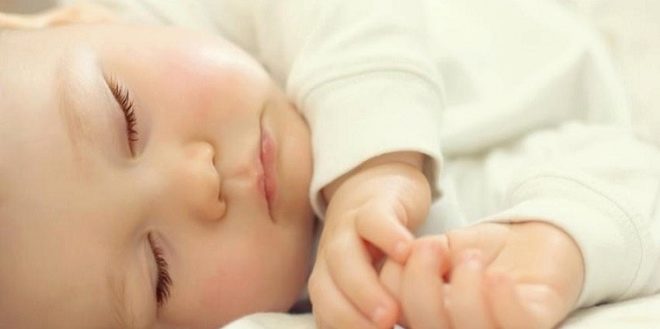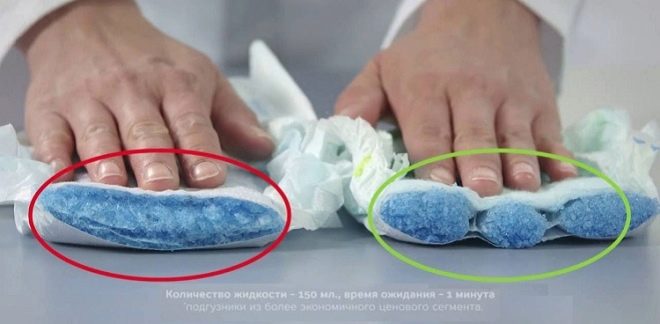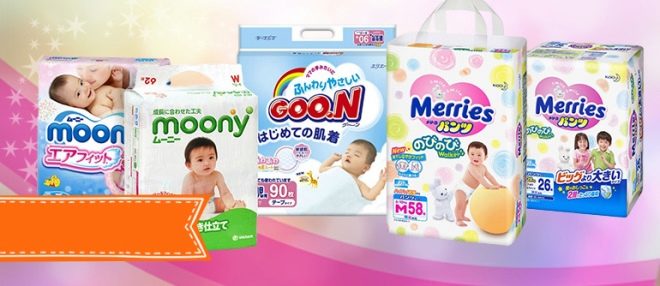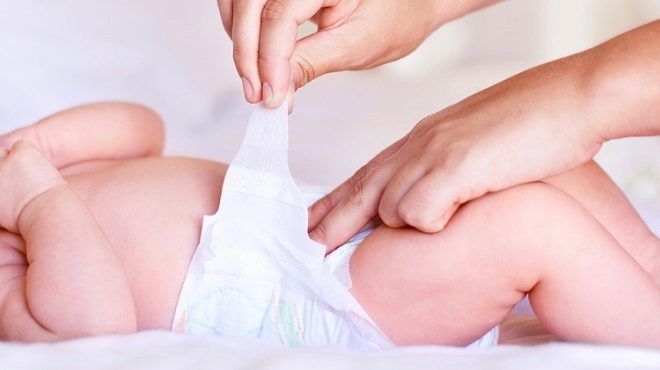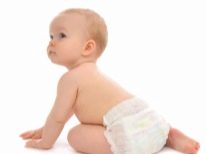Diapers for boys: harmful or not, how to choose and wear?
Not long ago, with the appearance of an infant in the house, the clothesline was filled with many multicolored diapers. Every day they had to be washed, boiled, dried and ironed, which consumed a huge amount of strength of the young mother. To date, in almost all countries for sale there are many different diapers, which greatly facilitate the process of caring for your baby.
With the advent of this device arose and many different versions of the benefits and dangers of diapers. Especially young parents are concerned about the safety of diapers for the normal functioning of the genitourinary system in male babies.
What are the differences from diapers for girls?
Pampers are special hygienic disposable products for children, made, as a rule, in the form of underwear, namely panties. Such underwear has an absorbing surface in the middle, and on the sides there are special velcro or rubber bands that fix diapers on the baby’s body. They differ in their size, depending on the height or age of the child. Up to 3 sizes there are practically no differences in one line of hygienic products, and starting from size 4-5 they are divided into diapers for boys and girls. Since the structure of the male genital organs is significantly different from the female, and the cut diapers for boys should be significantly different.
The location of the absorbent layer on men's diapers is not located at the bottom, as in the case of female models, but is shifted to the front. It is raised closer to the stomach, since it is in this direction that the urine of the male baby flows. For boys' diapers, the pattern should be such that there is free space ahead, in which the genitals should be placed comfortably. Traditionally, diapers for boys, as well as clothing and accessories, are performed in blue. They can be depicted cartoon characters and animals, cars or spaceships. Flowers or butterflies, cartoon princesses and animals are usually drawn on girls' diapers.
Diaper use
The most obvious and main plus of modern disposable hygienic means is a quiet sleep of the kid. Since the diaper absorbs all the liquid inside a special layer, the surface of the fabric adjacent to the skin will remain dry. Dry skin will not be covered with diaper rashes and irritations, it will not appear pockets of inflammation. The following advantage follows from the restful sleep of the baby - it is the restful sleep of the mother herself, who does not need to wake up every 20-30 minutes in order to re-fresh the diaper.
Velcro and elastic bands with which all models of diapers are equipped, allow the child's handles and legs to move freely. They do not affect the movement and at the same time do not dig into the body and do not slip from it. Disposable panties are simply discarded after use, which significantly saves time spent on washing and ironing ordinary diapers. When the baby is already growing up, special panty diapers without stickies will facilitate the process of teaching the child to the pot.
In addition, a diaper is an indispensable thing for any walk and on a trip with a baby, as it is not everywhere you can find public toilets, in which changing tables for mothers with babies are installed.
Possible harm
With the increased popularity of diapers, many myths about their harm, which have not been proven scientifically, have spread. It is considered that such hygienic means are especially harmful for boys, since their genitals, unlike female babies, are located not inside, but outside the body and are constantly in contact with the absorbent layer.
Myth 1 - diapers can cause infertility in men.
Surprisingly, according to some pediatric doctors, boys cannot wear diapers due to the fact that a rise in temperature in the groin area can lead to a reduction in sperm and infertility. In fact, it has been proved for quite some time that the boy’s reproductive system begins to develop and function no earlier than 8-9 years. In male babies, sperm in the ovaries is simply not produced, therefore Proper wearing of disposable hygiene products does not affect it.
Myth 2 - diapers causes allergies due to the effect of the "greenhouse"
Older models of diapers could really cause irritation on the baby’s skin, as she was constantly in contact with a wet cloth soaked in urine. Modern models are tailored in such a way and from such materials that all secretions are absorbed deep into a special layer, and the fabric adjacent to the baby’s body remains dry. The material of the rest of the diapers, except for the absorbent part, is made of a thin material that lets in enough air so that the boy's skin does not sweat or irritate.
Myth 3 - diapers bends the feet of the baby
Some believe that the curvature of the legs may depend on the fact that in childhood a diaper was put on the child, preventing him from walking. In fact, manufacturers of hygiene products develop the shape and size of the diaper, taking into account the baby's anatomy, which allows him to move most freely. Besides, leg curvature is what is laid in a person at the genetic level. It does not depend on diapers or diapers. This, by the way, explains the fact that even with the tight swaddling of babies, which was quite popular about 20-30 years ago, children with crooked legs grew up.
All this turns out to be an erroneous opinion, which is easily refuted by the slightest knowledge of medicine, biology, and the production methods of modern diapers. But in reality there are several possible negative effects that the improper use of baby diapers will bring. Constant wearing of diapers can lead to loss of urinary control in a child. If the boy is already more than three years old, and he still does not want to learn to go to the toilet on the pot, this may create a certain psychological dependence on diapers. To avoid this, you need to start teaching the child to the pot as early as possible.
Another negative consequence of the continuous wearing of a diaper is the inability to examine your body for an infant. Since the child cannot see and touch almost 1/3 of his body, he makes up the wrong idea about him. This can lead to fear of new things and slight delays in the development of the child, increased tearfulness and nervousness.
To prevent this trouble, sometimes you should leave your baby naked and in no case do not punish him for examining his body.
Optimal age
Diapers can be used from the very first days of the baby. In the sale of such products should be labeled "0 +" on the packaging. With the growth of a little boy, the size and models of diapers change.According to the recommendations of the leading pediatricians of the country, the optimal age for weaning a child from these hygiene products and for teaching him to use a baby pot is from one to two years old. During this year, a development of a certain part of the brain of the child, responsible for controlling urination and defecation, occurs.
The process is slow and can even last up to 2.5 or 3 years, however, you should not give up trying and be patient.
Top models rating
There are many ratings of various manufacturers and models of diapers, based on feedback from young parents, taking into account the reliability, price and usability of products.
- 1 place is occupied by the brand diapers Huggies. They are approved by Roskontrol and perfectly absorb even liquid baby stools.
- 2nd place buyers gave brand diapers NappyClub, which have one of the most affordable prices. They are based on Japanese and German absorbents and have excellent absorbency.
- 3rd place is occupied by diapers production Lovular, which are processed by special technology using hot steam and have a hypoallergenic coating.
In addition, the top ten includes not such well-known, but no less common brands Moony, GOO. N, YokoSun and Merries. But the famous Pampers, which have become not just a brand, but the name itself for any type of diaper, could not get into the top ten of the rating. Parents of babies complain of an unpleasant chemical smell and poor absorption of the goods of a famous manufacturer.
Criterias of choice
In order to choose a diaper in which the crumbs will be most comfortable, should pay attention to a few important points.
- Material. Best of all, if it is a thin and breathable fabric that stretches well, but does not tear.
- The size. Diapers are chosen strictly for the current size of the little boy. For example, products for children a year old and older can not be used for newborns.
- View. There are various diapers depending on the destination. For example, night diapers are larger in size, since at night the child is not actively moving and the absorbent layer can be made larger.
- Clasps. For the smallest, it is most convenient to use diapers with reusable velcro, as this will allow you to repeatedly check the dryness of the skin and the fullness of the diaper.
For 2-year-old boys are perfect hygienic panties with elastic, similar to ordinary underwear. They will facilitate the process of teaching the child to the pot and save from little trouble if the boy is still not doing well with this process.
- Side gum. They should be quite soft, so as not to pinch the internal organs of the baby, but at the same time strong, so that the diaper fits tightly to them. The wider this gum, the more comfortable it is for a child to wear a diaper.
- Indicator of fullness. Modern models of diapers are designed in such a way that they change the color of special indicator strips that signal that the hygienic product is filled and subject to change. It is very convenient on walks or on trips, as it allows you to check your baby without undressing him in the cold and drafts.
- Various additives against allergies and diaper rash. Some manufacturers put on sale diapers, the inner surface of which is pre-processed baby talcum powder or special creams. This allows you to wear hygiene pants, even boys with hypersensitive skin.
The process of putting on and replacing
You can change diapers in just a couple of minutes - this is an elementary process. However, lack of experience can cause some inconvenience. To exclude all kinds of mistakes, you should prepare in advance all the necessary items and a place where it will be convenient to dress the child. Old pampers must be carefully removed, ripping Velcro or ottyanuv gum at the waist. Wash baby's skin with warm water or wipe with special wet wipes.Smear the groin and buttocks area with a nourishing baby cream or sprinkle with talcum powder and leave the child naked for a while, so that the skin is ventilated.
In no case can not leave the child unattended for this period, he may fall or hurt himself. After 20 minutes, you should print a new diaper, lift the baby by the legs, not tearing his shoulder blade from the surface. A fresh diaper is tucked in the back under the baby's bottom, after which the legs go down and the front side of the product runs over the belly. Velcro fastened, and the side gum straightened so that the diaper does not flow from the side. After the product is worn, you need to check the comfort of the boy's movements, after which you can wear sliders or pants.
How often to change?
Even the most expensive and high-quality diapers can harm the baby, if you wear them correctly and wear them all the time. In order to minimize all risks, it is necessary to follow certain rules. You need to change the diaper at least once in 3 hours. This is best done after each emptying of the baby’s bladder. If the boy went "big", then you need not only to immediately replace the diaper, but also to soak the child with warm water. It is good if, when changing a diaper, a child will lie down for 20-30 minutes with bare skin. Such air baths will relieve the skin of the baby from irritation and diaper rash.
When buying disposable sanitary panties you need to know the correct size that is suitable for the child at the moment. Even if there are a few smaller packages left, or there is a larger size purchased for growth, you should not use them. A small diaper can squeeze the skin and impede the access of blood to the extremities of the child, there will be soreness and inflammation. A larger size will hang too loosely on the boy, which will not allow the diaper to properly absorb the baby’s waste products and will interfere with the movements.
To learn how to change the diaper, see the next Huggies workshop.
